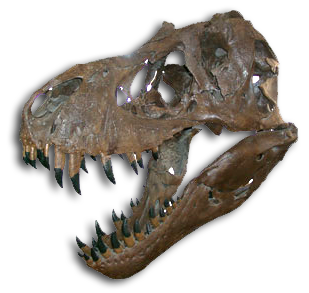Item Number
2164
Type
image
Description
Dimetrodon
Size
3 ft. 6 inches, Length: 5 ft. 5 inches
Age
Early Permian, Wolfcampian (299-280 MYA)
SciId
dimetrodon milleri
Status
in inventory
Display/Storage
Display
Building
Zuhl Museum
Original Site
Texas
Date Acquired
2018
Source
Paleotex
Gallery/Room\Floor
History of Life Gallery
Notes
Pelycosaur Skeleton Dimetrodon milleri Nickname:"Zoli" Age: Early Permian, Wolfcampian (299-280 MYA) Moran Formation in Archer County, Texas, USA Measures: 35 inches tall and 60 inches long This complete skeleton of Dimetrodon is as interesting and intriguing as it looks. The primitive non-mammalian synapsid (meaning one opening in the side of the skull) belonged to the group known as pelycosaurs, which had differentiated teeth and had developed a hard palate. The prominent "sail" consisting of elongated vertebral spines is the most recognizable feature of this ancient beast. It is theorized that the skin-covered "sail" was used for thermoregulation, or possibly even mating displays. Pelycosaurs dominated the prehistoric landscape for some 40 million years. They are more closely related to modern mammals than reptiles, and lived during the transition between the Pennsylvanian and Permian Period. Dimetrodon was the apex predator of its day along the lines of Megalodon and Tyrannosaurus rex - and lived an unbelievable ~100 million years before the Dinosaurs! Dimetrodon milleri is the oldest, and among the smallest, of the known species. "Zoli" came out of the vaulted Texas Red Beds of the Permian Basin. This fossil consists of approximately 95% real fossilized bone, composited from animals in nearby localities, but is "built" around a 40% associated creature. The reconstruction of the very impressive skeleton is based on the holotype specimen, which was nearly complete.
Preview

Description
Pelycosaur Skeleton Dimetrodon milleri Nickname:"Zoli" Age: Early Permian, Wolfcampian (299-280 MYA) Moran Formation in Archer County, Texas, USA Measures: 35 inches tall and 60 inches long This complete skeleton of Dimetrodon is as interesting and intriguing as it looks. The primitive non-mammalian synapsid (meaning one opening in the side of the skull) belonged to the group known as pelycosaurs, which had differentiated teeth and had developed a hard palate. The prominent "sail" consisting of elongated vertebral spines is the most recognizable feature of this ancient beast. It is theorized that the skin-covered "sail" was used for thermoregulation, or possibly even mating displays. Pelycosaurs dominated the prehistoric landscape for some 40 million years. They are more closely related to modern mammals than reptiles, and lived during the transition between the Pennsylvanian and Permian Period. Dimetrodon was the apex predator of its day along the lines of Megalodon and Tyrannosaurus rex - and lived an unbelievable ~100 million years before the Dinosaurs! Dimetrodon milleri is the oldest, and among the smallest, of the known species. "Zoli" came out of the vaulted Texas Red Beds of the Permian Basin. This fossil consists of approximately 95% real fossilized bone, composited from animals in nearby localities, but is "built" around a 40% associated creature. The reconstruction of the very impressive skeleton is based on the holotype specimen, which was nearly complete. 35x60
Keywords
Dimetrodon Pelycosaur Skeleton Dimetrodon milleri Nickname:"Zoli" Age: Early Permian, Wolfcampian (299-280 MYA) Moran Formation in Archer County, Texas, USA Measures: 35 inches tall and 60 inches long This complete skeleton of Dimetrodon is as interesting and intriguing as it looks. The primitive non-mammalian synapsid (meaning one opening in the side of the skull) belonged to the group known as pelycosaurs, which had differentiated teeth and had developed a hard palate. The prominent "sail" consisting of elongated vertebral spines is the most recognizable feature of this ancient beast. It is theorized that the skin-covered "sail" was used for thermoregulation, or possibly even mating displays. Pelycosaurs dominated the prehistoric landscape for some 40 million years. They are more closely related to modern mammals than reptiles, and lived during the transition between the Pennsylvanian and Permian Period. Dimetrodon was the apex predator of its day along the lines of Megalodon and Tyrannosaurus rex - and lived an unbelievable ~100 million years before the Dinosaurs! Dimetrodon milleri is the oldest, and among the smallest, of the known species. "Zoli" came out of the vaulted Texas Red Beds of the Permian Basin. This fossil consists of approximately 95% real fossilized bone, composited from animals in nearby localities, but is "built" around a 40% associated creature. The reconstruction of the very impressive skeleton is based on the holotype specimen, which was nearly complete. 2018 Early Permian, Wolfcampian (299-280 MYA) Fossil
Keywords
Dimetrodon Pelycosaur Skeleton Dimetrodon milleri Nickname:"Zoli" Age: Early Permian, Wolfcampian (299-280 MYA) Moran Formation in Archer County, Texas, USA Measures: 35 inches tall and 60 inches long This complete skeleton of Dimetrodon is as interesting and intriguing as it looks. The primitive non-mammalian synapsid (meaning one opening in the side of the skull) belonged to the group known as pelycosaurs, which had differentiated teeth and had developed a hard palate. The prominent "sail" consisting of elongated vertebral spines is the most recognizable feature of this ancient beast. It is theorized that the skin-covered "sail" was used for thermoregulation, or possibly even mating displays. Pelycosaurs dominated the prehistoric landscape for some 40 million years. They are more closely related to modern mammals than reptiles, and lived during the transition between the Pennsylvanian and Permian Period. Dimetrodon was the apex predator of its day along the lines of Megalodon and Tyrannosaurus rex - and lived an unbelievable ~100 million years before the Dinosaurs! Dimetrodon milleri is the oldest, and among the smallest, of the known species. "Zoli" came out of the vaulted Texas Red Beds of the Permian Basin. This fossil consists of approximately 95% real fossilized bone, composited from animals in nearby localities, but is "built" around a 40% associated creature. The reconstruction of the very impressive skeleton is based on the holotype specimen, which was nearly complete. 2018 Early Permian, Wolfcampian (299-280 MYA) Fossil


